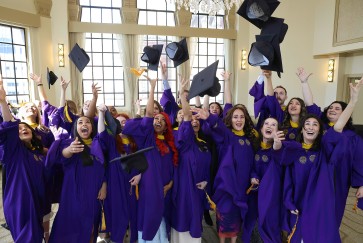The Northwestern Class of 2025 comprises countless heartening and unique personal stories. But this incoming cohort of first-year students — almost 2,100 in all — also shares a common bond forged during the challenging transition from high school to college amid the global pandemic of COVID-19.
As smart, talented, curious, compassionate and resilient as any class of Wildcats before them, these students also make up the most diverse incoming class in University history. They come from nearly every state in the country and every corner of the world.
Who they are and where they come from
The class includes record numbers of students who identify as Black/African American, Hispanic/Latino/a/x, Native, Indigenous or first-generation and/or low income. This is the first Northwestern class in which more than half the students identify as Black, Indigenous and people of color (BIPOC).
- More than 10% of incoming students come from over 80 countries outside the U.S., nearly twice the international student population of 10 years ago.
- Approximately 6% are Chicago Public School graduates.
- More than 20% received Federal Pell Grants.
- Black-identifying students make up 12% of the class, up nearly 4% from five years ago and nearly twice what it was 10 years ago.
- Hispanic/Latino/a/x representation is nearly 17%, up more than 10% over the past decade.
- Nearly 2% are Native- or Indigenous-identifying students.
- More than 15% identify as first-generation college students.
“We are proud to call these students our own,” President Morton Schapiro said. “They’ve all come so far and accomplished so much, and we’re excited to see the impact they make on Northwestern and, ultimately, the world at large.”
We are proud to call these students our own. They’ve all come so far and accomplished so much, and we’re excited to see the impact they make on Northwestern and, ultimately, the world at large.”
The first-year applicant pool was nearly 48,000, up more than 20% over last year, with a 7% admit rate that is roughly half of what it was a decade ago. The yield, conversely, has grown over 50% in the past decade, to over 60% for the incoming class, which means a significant increase in the percentage of students who chose to enroll at Northwestern upon admission.
That yield has been growing steadily, first topping 50% in 2017 following the University’s shift to a loan-free financial aid policy.
“Northwestern is one of fewer than 20 institutions nationwide that combine need-blind admissions with a commitment to meeting families’ full financial need through loan-free aid awards,” noted Chris Watson, dean of undergraduate enrollment and associate vice president for student outreach. “This policy has accelerated our efforts to recruit and enroll students with as diverse an array of backgrounds, experiences and perspectives as possible.”
How they found their fit
This year’s lower admit rate was a function of the larger applicant pool. That increase is likely due to a constellation of factors, according to the Office of Undergraduate Admission. Given standardized test cancellations and anticipated registration challenges caused by COVID-19, Northwestern has adopted a test-optional policy for both the 2020-21 and 2021-22 admission cycles, which has fueled applications.
But another driver of this application growth is digital outreach to prospective students. At the dawn of the pandemic, it was commonly called a "pivot" from the familiar on-campus tours and face-to-face meet-and-greets. But barriers to visiting campus in person have always been a reality for prospective students due to constraints of geography, time and socioeconomics. And Northwestern, like many other schools, has since adopted an array of digital programs to not only convey the school’s core spirit and sense of community but also push the signal out to new and different places around the country and the world — or wherever someone might happen to bump into Northwestern via YouTube.
Indeed, new paths to college access have opened through live-shot campus walks, video conversations with current students, live Instagram Q&As and Facebook groups, as well as panels with administrators from areas like Residential Services, Campus Inclusion & Community, the Provost’s Office, Pre-Health Advising, New Student and Family Programs, Career Advancement, Northwestern Alumni Association, Athletics and The Garage.
“The opportunity to innovate in the digital space has proved to be a real silver lining of the pandemic,” said Liz Kinsley, associate dean and director of undergraduate admission. “Our committee reviewed applications from more than 9,000 secondary schools this past cycle — considerably more than last — and we’re seeing applicants in new places in large part because we can now give them more meaningful ways to engage with Northwestern from afar.”
“Even so, as much as we loved meeting the Class of 2025 and showing them the meaning of Purple Pride over our screens, it was very special to see them march through the Weber Arch together in person last week,” she said.
Diversity across professional schools
- The Kellogg School of Management welcomed 508 students to its incoming class this fall with its highest-ever representation of women, at 49%.
- Northwestern University Feinberg School of Medicine welcomed 160 incoming students, 22% of whom come from groups underrepresented in medicine.
- Of the nearly 250 new students in the Northwestern Pritzker School of Law, 56% are women and 45% are of underrepresented minority groups.
- The Graduate School, which is celebrating 125 years since the first Ph.D. conferral at Northwestern, will welcome more than 500 new Ph.D. students this fall and it anticipates that 52% will be women while 36% will be international.

